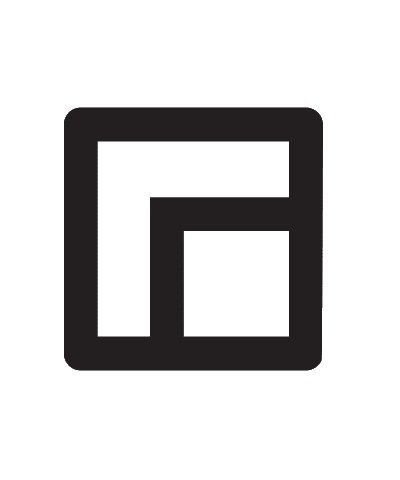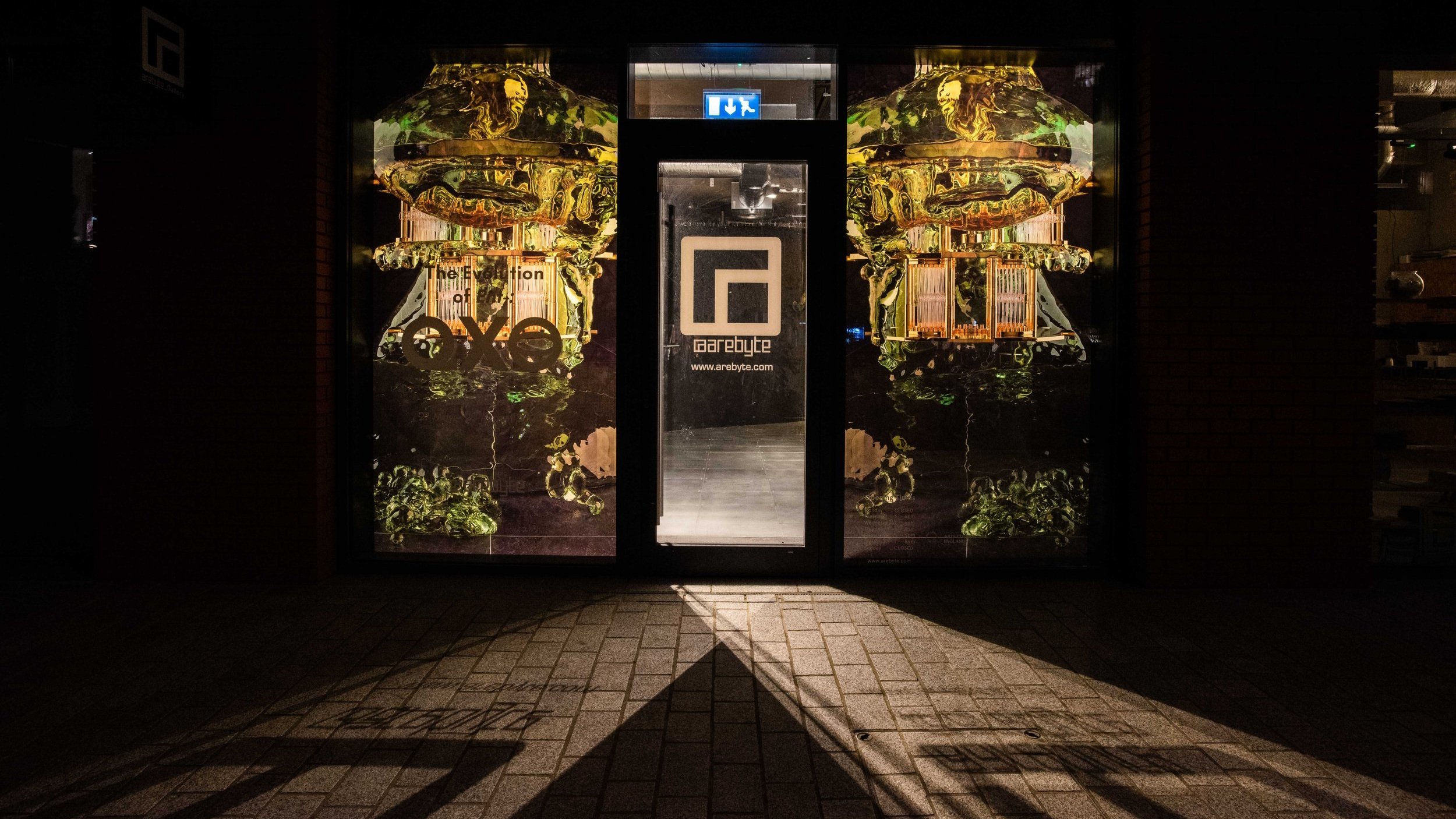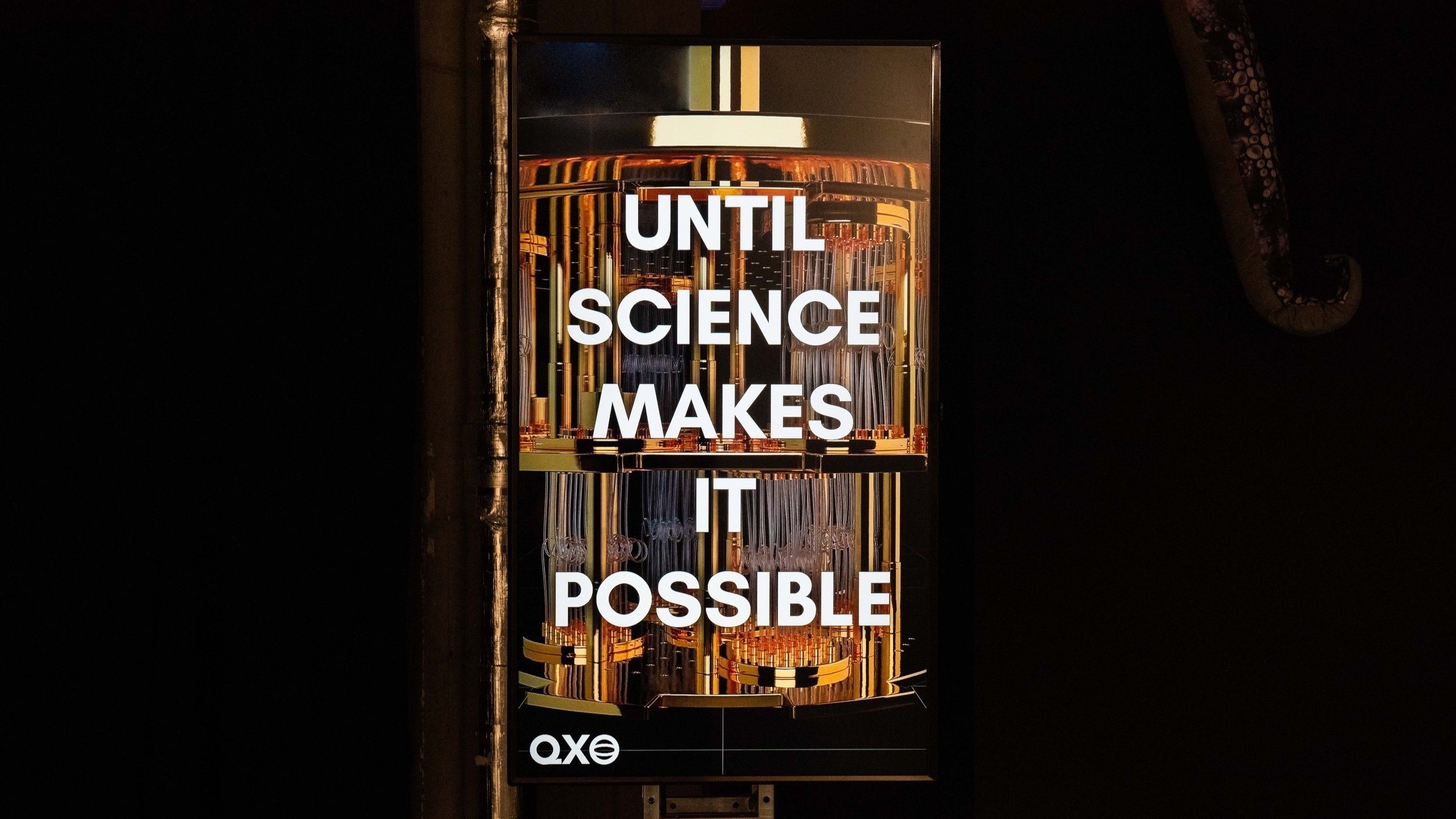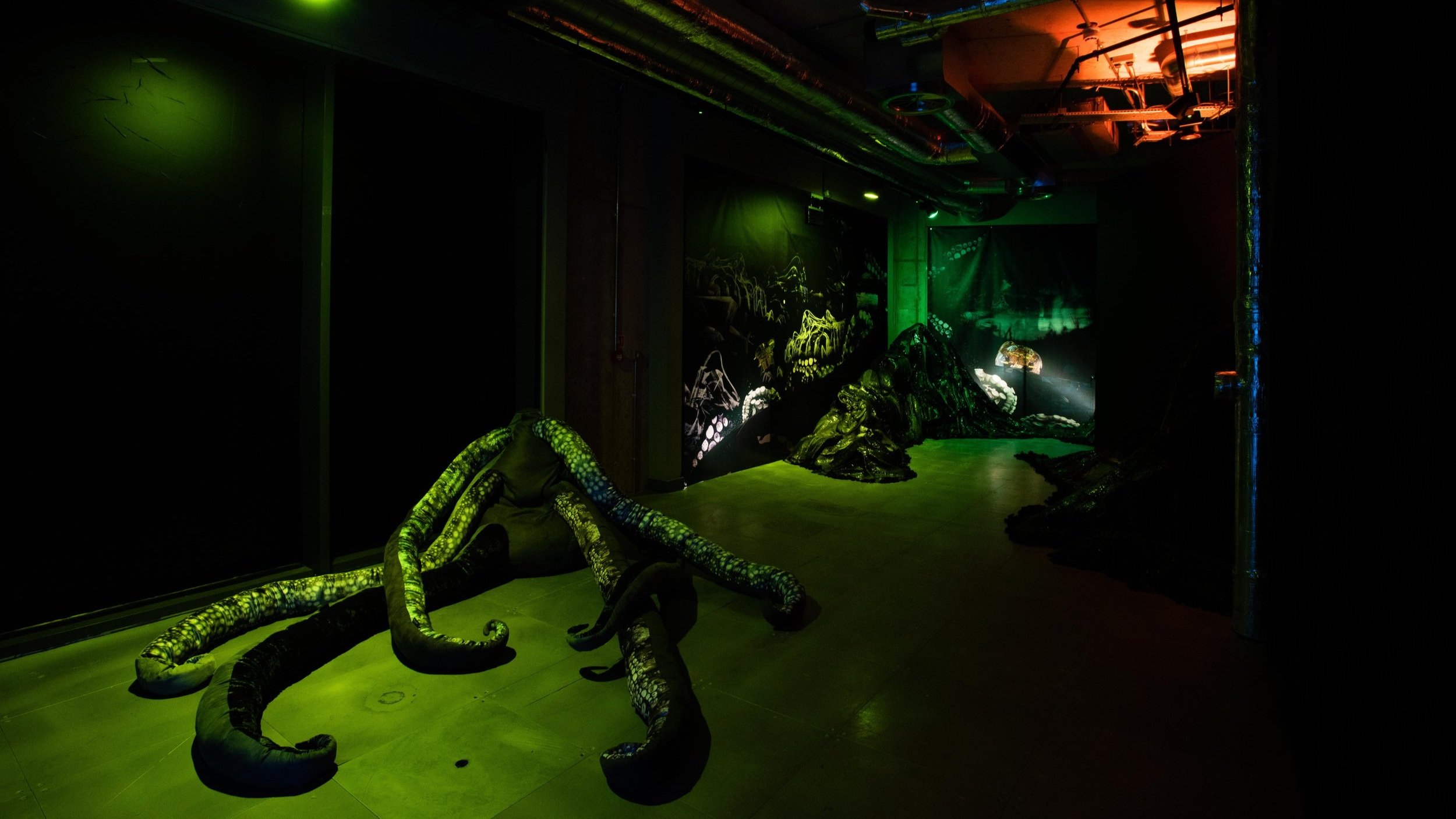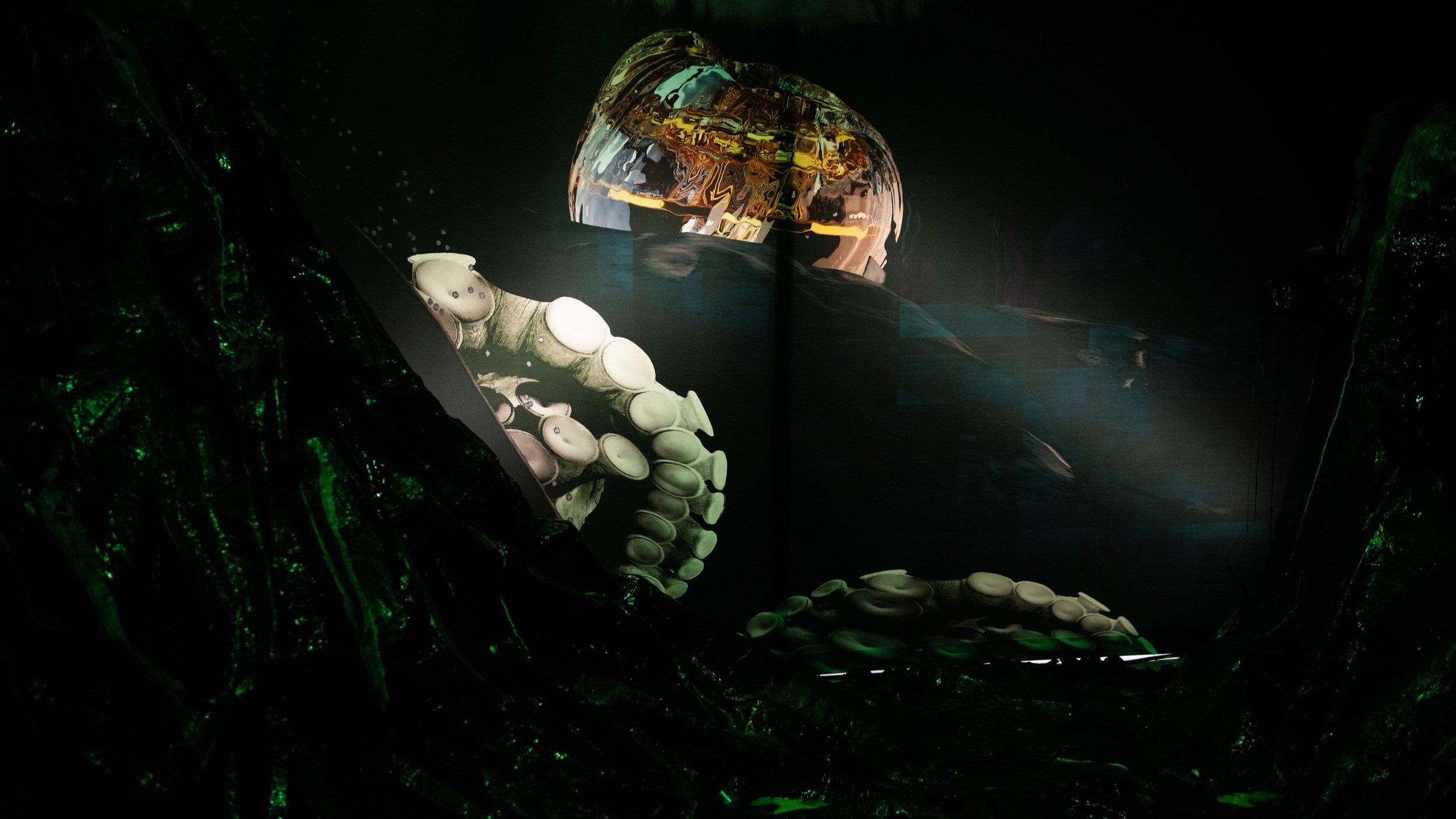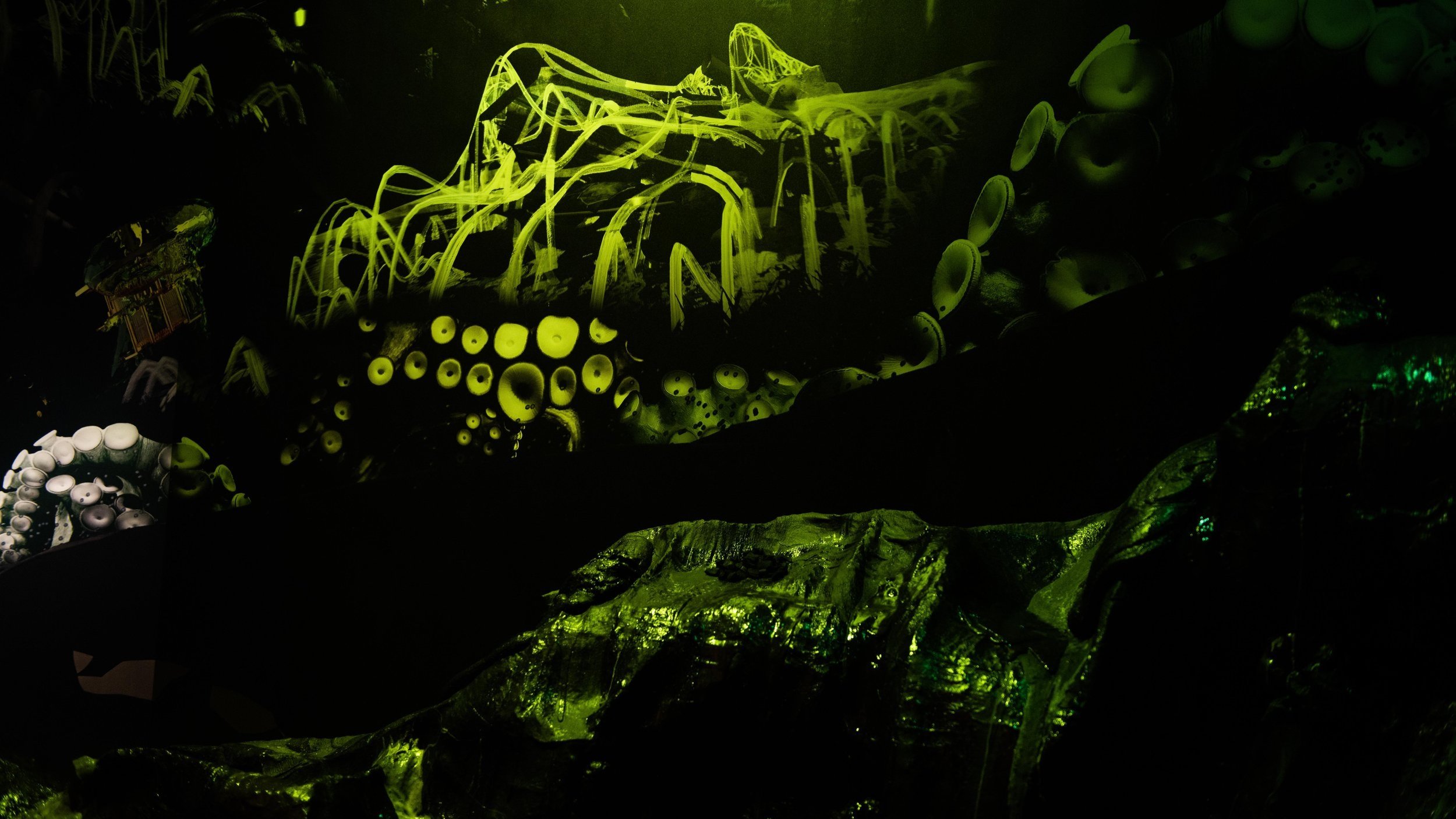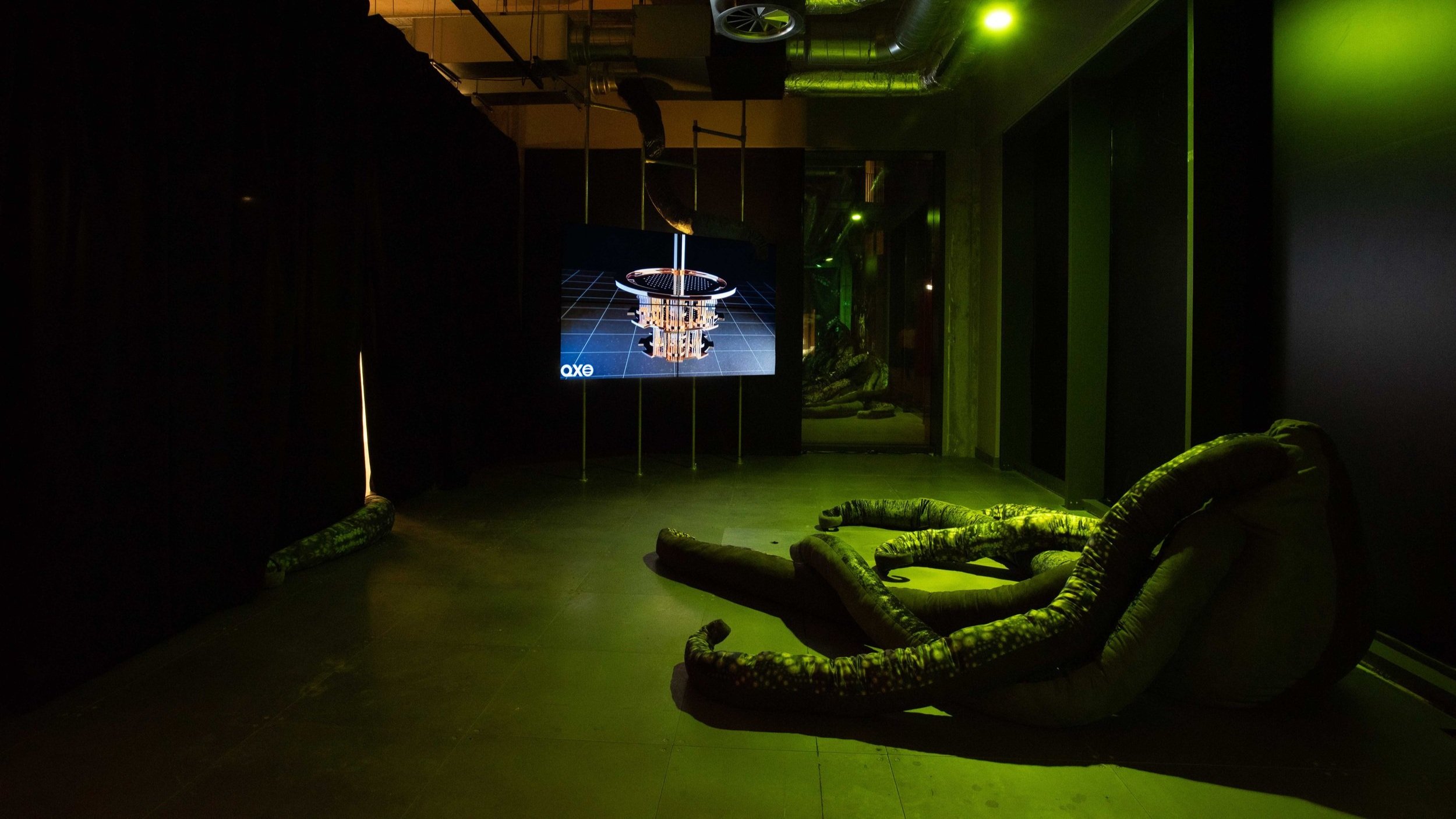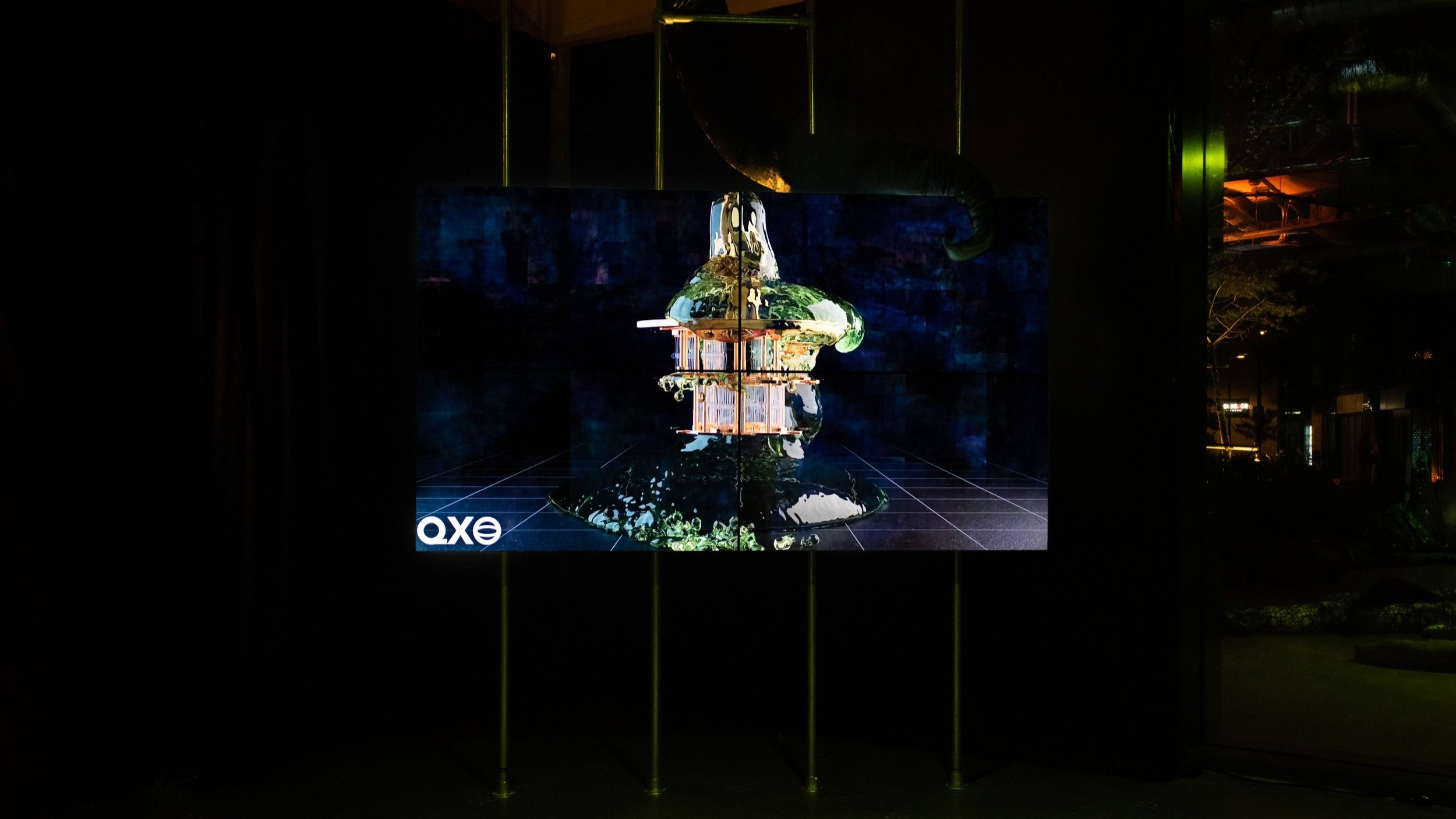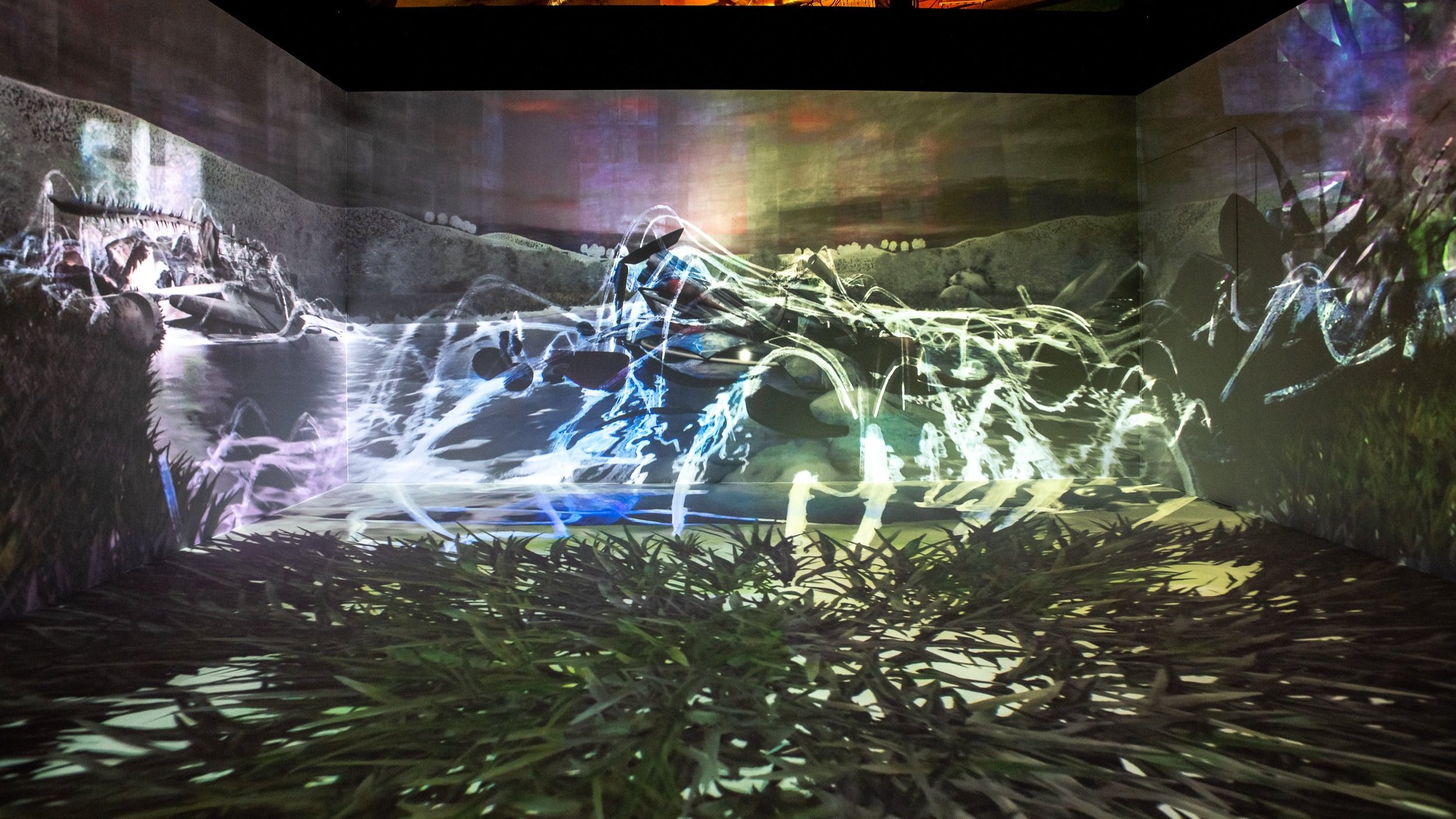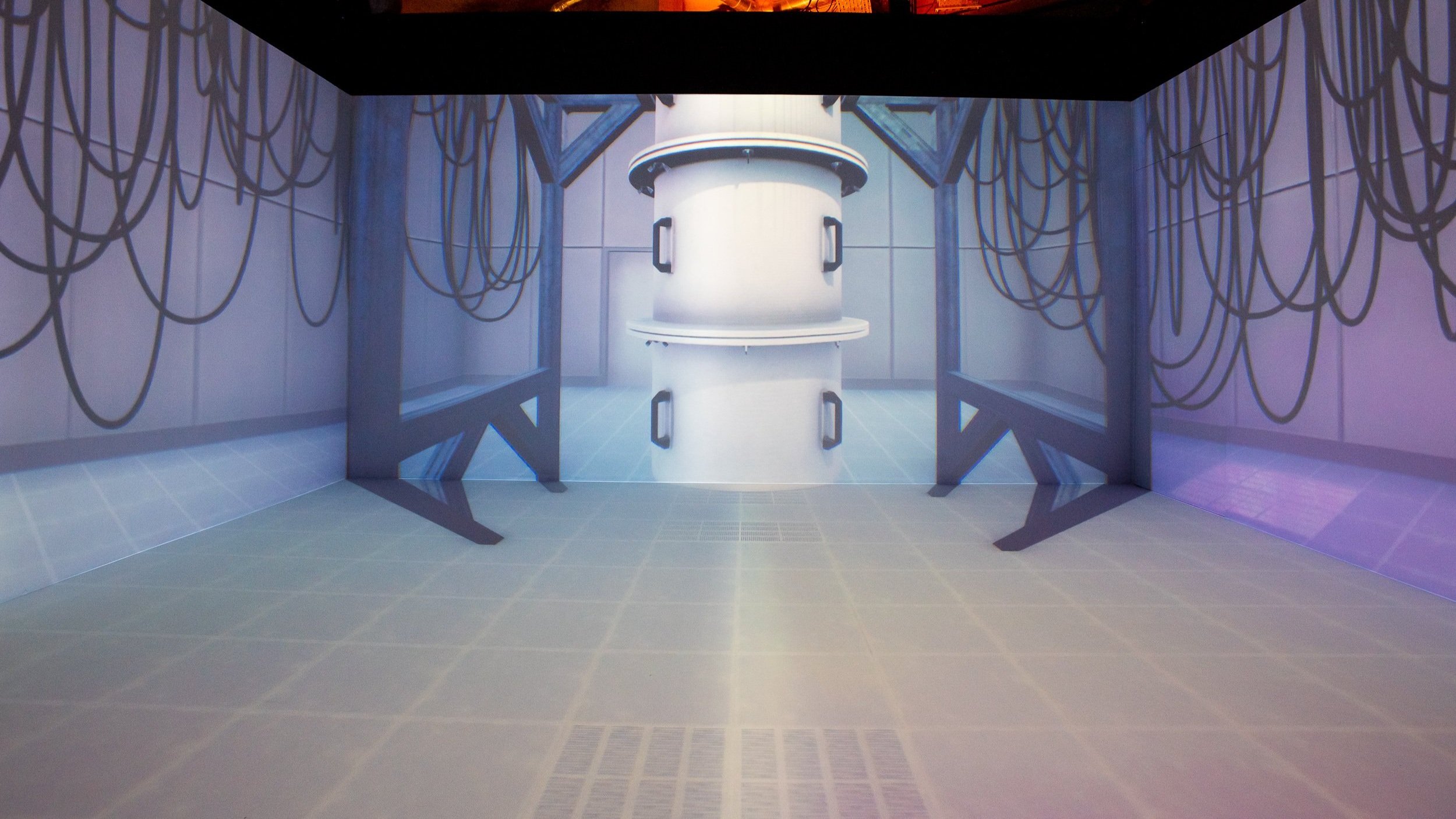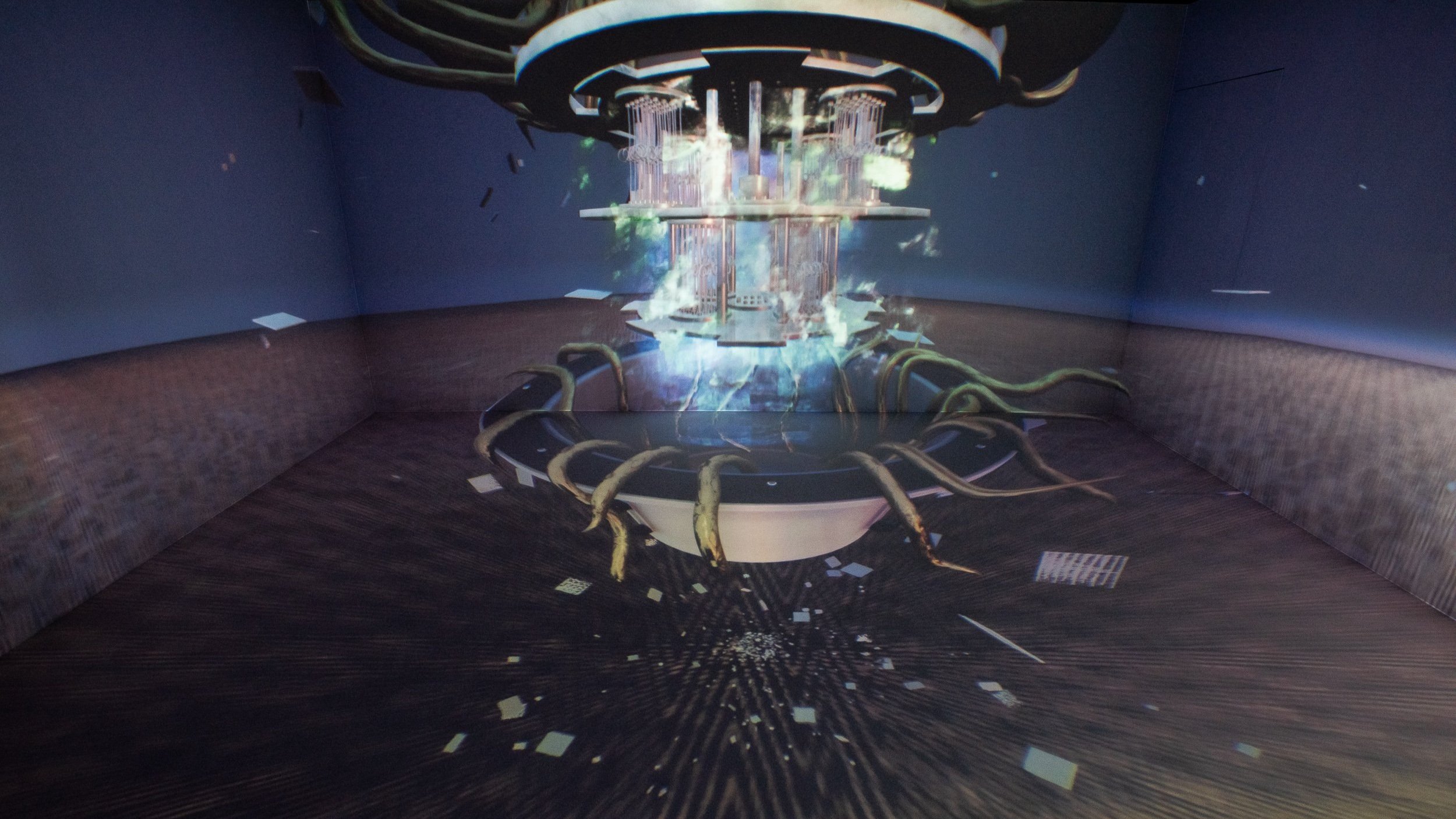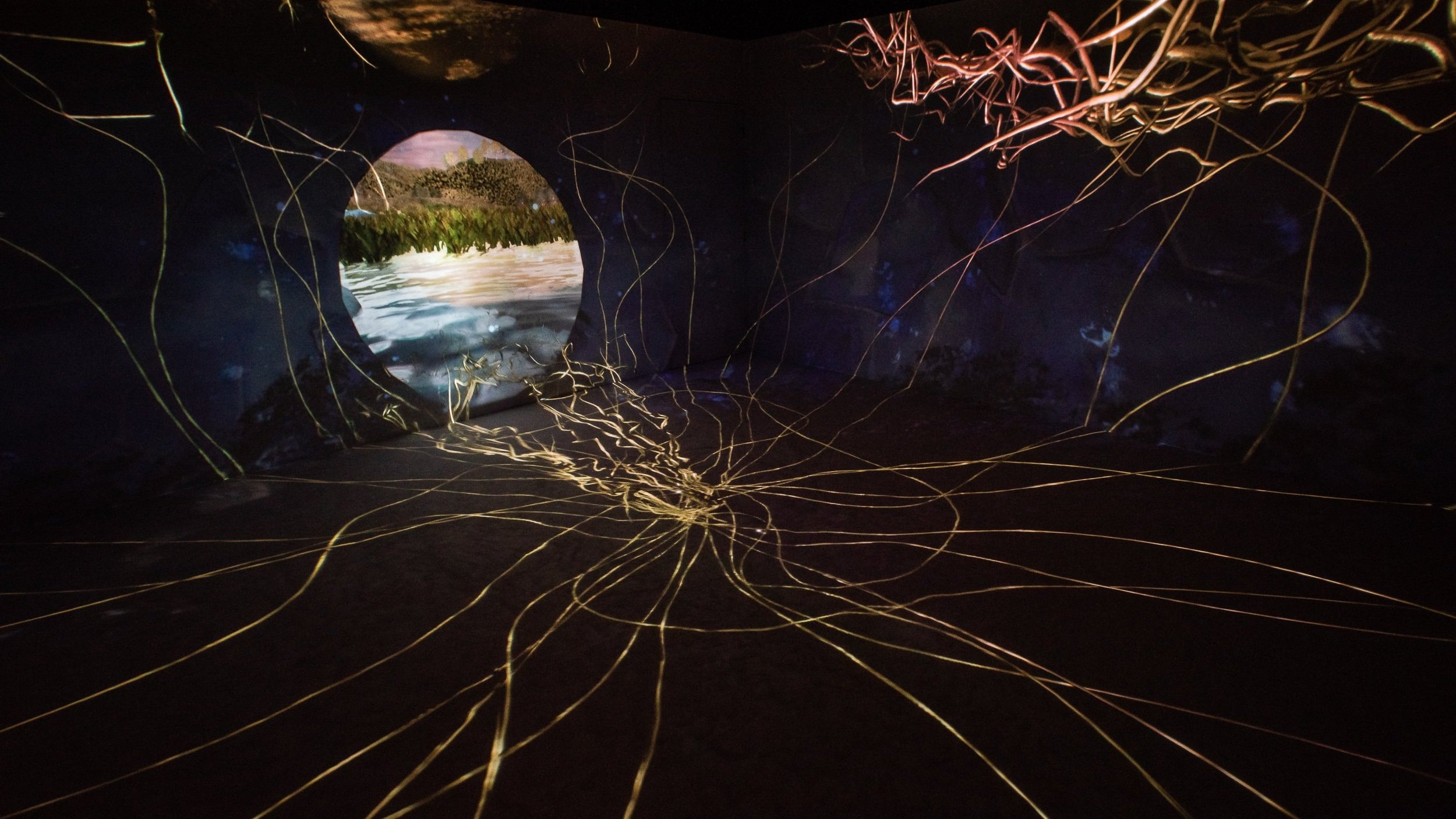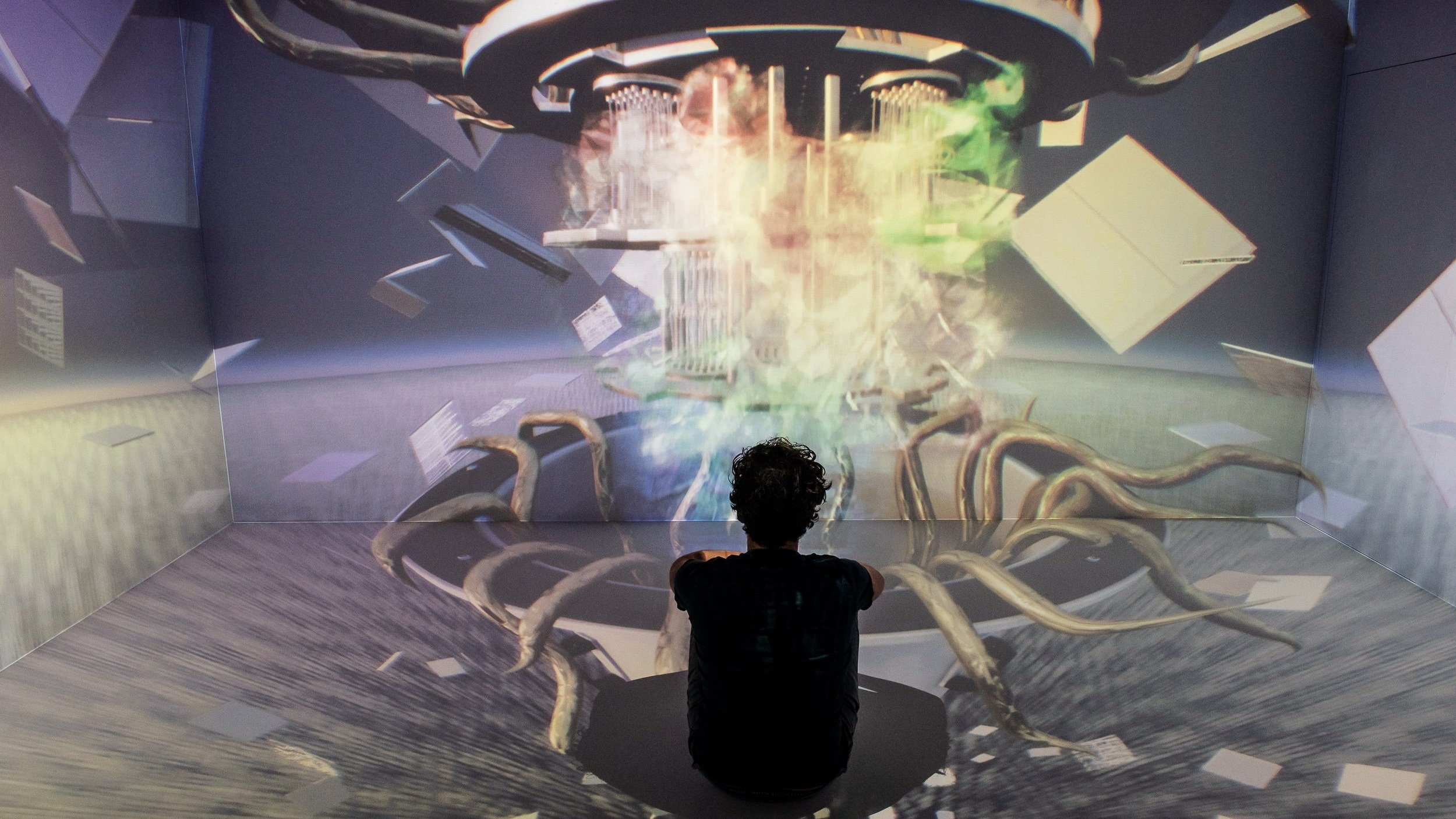The Evolution of Ent-: QX
Libby Heaney
Part of arebyte 2022/23 programme Sci-Fi
Opening Event : Thur 26 May 2022 6pm
27 May - 20 Aug 2022
Tue - Sat 1-6 pm
Explore parallel worlds in an immersive experience
probing the many futures of powerful new quantum computing systems.
arebyte Gallery presents The Evolution of Ent-: QX, an exhibition by UK artist and quantum physicist Libby Heaney, the first immersive experience using quantum computing as both medium and subject matter.
Commissioned by LAS (Light Art Space) and first shown at the Schering Stiftung in Berlin, 10 February – 1 May, 2022, the 360˚ projection Ent- takes audiences through three earthly layers of quantum experiments containing quantum hybrid lifeforms and pulsating liquid worlds filled with fantastical creatures zipping in and out of dimensions. Libby Heaney’s The Evolution of Ent-: QX expands on the immersive work of Ent- where Heaney experimented with self-written quantum code to manipulate and animate her own paintings referencing the central panel of Hieronymus Bosch’s famous triptych The Garden of Earthly Delights (c.1490–1510) to create hybrid organisms, breathing landscapes and exploding structures.
For arebyte Gallery, the perimeters of the rhetoric surrounding quantum computing are expanded through critical attention paid to the way technology and arts communicate the advancements in this area. This new presentation of Ent- pushes the rhetoric surrounding the use of quantum technologies and all it encompasses forward to a more critical space of enquiry and parody.
Adopting the hyperbolic language of Big Tech product launches, the viewer finds themselves within the apparent waiting room of the QX offices, the pseudo-company of applied quantum computing Heaney has fabricated to subvert the meanings supplanted onto quantum technologies by corporate powers with the ultimate gains of capitalist growth and monopolised power. The Quantum eXperience and the Instagrammable effect this work might produce illustrates the power of such spectacles within tech companies. Here Heaney parodies how Big Tech makes use of the immersive experience as a capitalist device to sell software, as well as the application of exaggerated metrics, embellished language and captivating visuals. Heaney is preying on the seductive nature of the immersive experience to encourage sharing, promoting the immersion and the viewer’s sharing of it under the guise of advertisement.
The work here is owned by and in service of Big Tech and profit: no longer a speculative avenue for experimental and hypothetical visions for a future. However, the quantum discussed in the exhibition seeks out a more double-edged potential; quantum computing as a radical avenue to valuing shapeshifting pluralities and strong entanglements away from profit, consumer and power. The rise of quantum computing is anticipated to accelerate surveillance capitalism and disrupt existing encryption methods relied upon for privacy and data protection. In Heaney’s work, we’re asked to consider how the drive for solutionism and profit at the core of new technological developments is prohibiting other alternatives that go against current modes of surveillance capitalism and control.
The two films presented before entering Ent- show the methods in which corporate tech companies speak about how they can use quantum computing to problem solve. Slick visuals depicting rendered quantum computers are mixed with repetitive and exaggerated slogans mostly lifted from tech companies themselves, idioms that place profit and statistics over anything else. Meanwhile, outside of the Black Box, non-human quantum slimeballs are wreaking havoc on QX’s plans by hijacking superconducting quantum dimensions to insert entropy - a plurality of possible alternatives - into QXs carefully crafted research. Visitors are engulfed in the tentacle arms of seating made in collaboration with Rosie Gibbens whilst they watch the final film, a sarcastic end to the criticisms of big tech and technological advancements.
In this surreal science-fiction story, we see the perils of what happens when future quantum computers are combined with distractive techniques already used on current AI-driven social media platforms and within Instagrammable corporate immersive experiences. Contrary to the way quantum is contextualised, the physics that underpins quantum computing is more fluid and slime-like in the way it behaves: quantum particles behave like slimy substances through their wave and particle properties: blurring, morphing, melting, congealing and shapeshifting, suggesting that quantum computers could instead be used to move away from the binary to a plural, shape-shifting landscape of deep interconnections, where the very notion of the individual even becomes irrelevant. In this alternative plural landscape, immersive art experiences could instead be used to lead audiences into these new territories and away from the superficial and immediate spectacle where form supersedes content.
The new visual language created via Ent- provides a starting point for future alternatives to how we think, talk, and enact upon political, social and environmental issues. The idea of something being in multiple states at the same time - the quantum superposition - could be another way to rethink gender, for example, or as a metaphor to reimagine hierarchical relations within institutions or governments. The way that quantum entanglement - a phenomenon in which entities exhibit strong correlations that cannot be explained by classical physics - could be coupled with the entwined state that lies within all matter leaves the areas of futurity, responsibility and kinship (amongst others) open to new interpretations.
In whatever way the quantum field is explored and extrapolated in The Evolution of Ent-: QX, for Heaney the importance lies within subverting “ the endless categorizations and control of humans and non-humans alike” to provide real-world, tangible new pursuits that resist the alienation caused by the pursuit of never-ending profits.
EVENTS PROGRAMME
Opening Event
Date: Thur 26th of May 6pm - 9pm
Location: arebyte Gallery
Panel Discussion: Quantum Slimifications
The discussion invites Mónica Bello (Curator, Head of Arts at CERN), Nora N. Khan (Curator and Critic) and Libby Heaney (Artist and Quantum Physicist) to expand on the possibilities of Quantum Computing inside and outside of the art world.
Curated Tour
Date: Tue 9th Aug, 6:30pm - 7:30pm
Location: arebyte Gallery
A tour of The Evolution of Ent-: QX with arebyte’s curator Rebecca Edwards and arebyte’s creative director Nimrod Vardi
arebyte x Serpentine presents:
Libby Heaney plays Hivemind
Date: Tue 16th of Aug, 6PM BST
Location: Online, Live-stream via Twitch
Libby will play Hivemind, a virtual knowledge game developed by serpentine in collaboration with the Trust. She will use the game to talk more deeply about her research process and how she uses quantum computing as a tool in her work
EXHIBITION CREDITS
Immersive quantum projection (Ent-)
Libby Heaney, Quantum computing developer, artist
James B. Stringer, Producer and experience design
Jira Duguid, Lead developer
Gabriel Stones, Developer
James B. Stringer, Composition (music and sound)
Silke Briel, LAS exhibition videographer (extracts used in QX product launch video)
Commissioned by Light Art Space (LAS), 2022
Chris Macinnes, Charles Stanton-Jones, Technicians
Tomáš Cingl, Lead build
Video works, banner works, built environment
Libby Heaney, artist
Jamie Maule, Sound Distortion
Commissioned by arebyte, 2022
Sculptural seating
Rosie Gibbens, Soft sculpture artist
Commissioned by arebyte, 2022
Projection engineered by Optoma
Exhibition supported by Arts Council England
Max colson, Installation photographer
READ THE EXHIBITION BOOKLET
Delve into TROUBLING QUANTUM a text written by curator and writer Lucy Solitt in collaboration with Libby Heaney (quantum consultant).
Commissioned by Goethe-Institut London as part of the “Living in a Quantum State” project.
Lucy Rose Sollitt is a philosopher, curator and writer. Her research-led practice maps the contours of emerging art and how it intersects with technologies, economies and ecologies.
Copyright: CC BY-SA.
ARTIST BIO
Libby Heaney is a British artist and lecturer who holds a PhD in Quantum Information Science from the University of Leeds and an MA in Art and Science from Central Saint Martins in London. She has exhibited widely in galleries and institutions in the UK and internationally, including solo exhibitions at LAS, Berlin (2022) Holden Gallery, Manchester (2021); Goethe Institut, London (2019); Emmanuel Church, Loughborough (2021) as part of Radar, Loughborough University’s contemporary art programme; and at Non-Space Gallery, Aarhus (2017) as part of their EU Capital of Culture programming. Group shows include RMIT Gallery, Melbourne (2021); Art-AI Festival, Leicester (2021); MUTEK, Montreal (2021); Etopia Center for Art & Technology, Zaragoza (2021); arebyte Gallery, London (online 2020); LUX with Hervisions (online 2020); Tate Modern, London (2016, 2019); ICA, London (2019); V&A, London (2018); Barbican, London (2019); Somerset House, London (2019); Sheffield Documentary Festival (2018); Science Gallery, Dublin ( 2017, 2018, 2019, 2021); Sonar+D, Barcelona with the British Council (2017); Ars Electronica, Linz (2017); CogX, London (2018); and Telefonica Fundacion, Lima with the British Council (2017).
Light Art Space (LAS) is a Berlin-based art foundation that brings together art, technology and science. Committed to new ways of presenting art, LAS commissions experimental projects in unconventional spaces, both physical and digital. LAS is dedicated to future thinking and light is the foundation’s guiding principle – a symbol of imagination, discovery and innovation.
DESKTOP TOUR
Series hosted by artist Marc Blazel where artists talk through their desktop, key folders, bookmarks, and software they use in their work.
TALKING HEADS
Experts within the digital arts sector are invited to review and discuss the works of the exhibiting artist.
